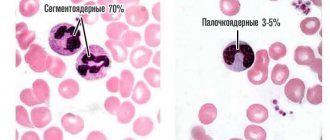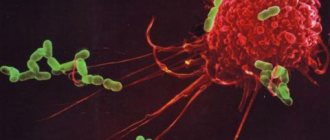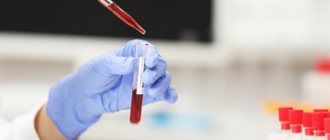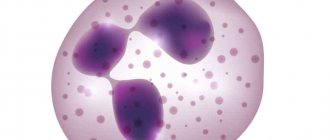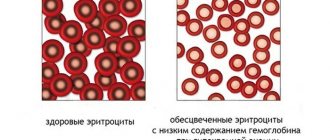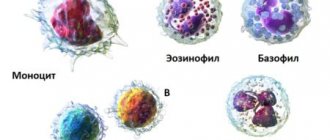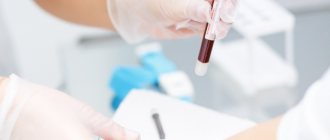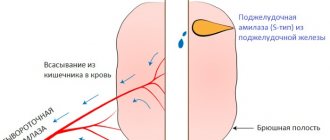White blood cells or leukocytes themselves are heterogeneous. This is the general name for five structures. The goal of all of them is the same: the fight against infectious and other abnormal agents that invade the human body. Accordingly, they form the basis of the immune system.
Neutrophils are one of the subtypes of leukocytes. They are most numerous in relation to other similar cells and make up up to 70% of the total mass of such cells. They perform important functions but are heterogeneous in nature.
In a sense, these structures are universal, capable of fighting most types of pathogens and foreign objects. Deviations from the norm always indicate the development of pathological processes, not counting a small number of subjective reasons, for example, taking certain medications.
The appropriateness of treatment is determined by the specific clinical situation. Neutrophils in a blood test reflect immune function, therefore any deviation is potentially dangerous, which is what doctors proceed from when considering the need for therapy.
Functions of neutrophils
These cells solve a large group of specific tasks facing the human body’s defenses:
Release of bactericidal substances
The structures of cytological units contain specialized compounds that have the ability to kill pathogenic flora. When a target is detected, the neutrophil releases a substance that dissolves the cell membranes of the pathogen.
Thus, the genetic material is not encapsulated and the bacterium dies. This is one of the main mechanisms of neutrophil activity.
Antigen binding
The cells in question on the membranes have special receptors for specific immunoglobulins of class G; they are the most common in the body and are highly active in the fight against infectious agents of all types.
Due to the ability to bind such substances, neutrophils can quickly transport them to the site of injury to enhance the immune response. Thus, the destruction of pathogens is achieved much faster.
Direct absorption of microorganisms
Formed cells are capable of phagocytosis. They are large and aggressive enough to destroy bacteria by “eating” them. On average, a neutrophil can eliminate up to 20-30 foreign structures using different methods. Which indicates its high efficiency.
Inhibition and inactivation of viral agents
White blood cells have the ability to reduce the rate of replication of foreign pathogens and reduce the productivity of their existence. In favorable cases, complete suppression of the structures is achieved, due to which the inflammatory processes disappear.
The functions of neutrophils ultimately come down to one thing - the destruction of bacteria, viruses, fungi, and other objects in various ways. Therefore, an increase in the Neut indicator in a blood test indicates an immune response, be it a reaction to an infectious lesion or allergic processes. Next, you need to understand it in detail, in essence.
Kinds
Neutrophils, despite the same name, are also heterogeneous. There are several types of these. Depending on the functional purpose (narrow specialization) or the degree of readiness for work.
In total, four types can be defined:
- Myelocyte. Relatively speaking, it cannot be called a type of white blood cell. This is an extremely immature cell. In essence, it has not even differentiated yet. This is a rough “preparation” of the organism for future transformation into other structures. Not necessarily neutrophils.
Transformation into anything is possible: from a platelet to an eosinophil. Normally, such structures should not exist in the bloodstream at all. They concentrate in the bone marrow and are finally formed there, only then they enter the body and begin to do their job.
- Young or immature neutrophils. Intermediate form. It is also stored in the place of its own synthesis, providing a conditional reserve. In case more immune cells need to be released. Similar varieties are also absent from the bloodstream. Because they are not yet capable of working.
On the other hand, as a result of random phenomena, a small number of them may be released. This is not critical, but the quantity should be within the error level. About 0.1-1%, with a possible downward deviation. All obvious changes indicate the development of one or another pathological process in the body.
- Band neutrophils. Make up a minimum of the total mass. Not more than 5% of the quantity. They got their name due to the peculiarities of their shape, which is clearly visible during microscopic analysis. These cells have approximately the same functions, but are more highly specialized. They get involved out of necessity when the majority cannot cope.
- Neutrophils are segmented. The most numerous subtype of white blood cells. According to various estimates, it accounts for up to 70% of the number of structures. Solve the problems described above constantly and fully. The work of neutrophils of this type is especially noticeable during the development of an infectious-inflammatory process in the body.
There are thus only two functionally active species. Both of them are approximately equivalent in features, role and potential for combating pathogenic agents, microorganisms, viruses, fungi.
What are segmented neutrophils
Neutrophil cells are a mature type of leukocyte that resist infectious agents. The resulting neutrophil matures in the bone marrow to a band form, then its cell nucleus is segmented (divided): a segmented cell is formed. Neutrophils transported through the vascular bed eliminate (neutralize) pathogens of bacterial or fungal diseases that have entered the body.
The destruction of a foreign agent occurs due to its envelopment by a neutrophil. A leukocyte that dies along with a harmful object releases special compounds that attract other cells to the source, which are assigned protective functions.
Standard tables
Neutrophils are designated in a blood test as Neut, and the number of cells is calculated as a percentage. But in laboratory and clinical practice, the absolute content of neutrophils is also used, this is an indicator that is calculated in the number of units per liter of blood.
Which method will be used depends on the specific institution and research methods.
Among women
The indicators vary quite widely. On average, the norm of neutrophils in the blood of women is 50-59%, which is slightly higher than that of men. This is due to the peculiarities of the immune system and other factors.
| Age (years) | Neutrophils as a percentage (calculated according to the most numerous variety - segmented) |
| 16-18 | 51-56% |
| 18-21 | 52-57% |
| 22-35 | 52-59% |
| 35-45 | 51-58% |
| 45-60 | 50-55% |
| After 60 years | 52-58% |
The data in the table is approximate; slight individual fluctuations downward (but not upward) are possible. It is also necessary to take into account the patient’s condition at the time of the study.
Peak hormonal events affect the concentration of neutrophils. Whether it’s active puberty (especially with delayed formation), the menstrual cycle, pregnancy.
In men
In men, normal corpuscle values are not much lower (49-57%), in general, we are talking about a discrepancy of several percent. Depending on the case. This is a general rule.
| Years of life | Levels of segmented neutrophils |
| 16-18 | 50-54% |
| 18-21 | 50-55% |
| 22-35 | 51-57% |
| 35-45 | 50-54% |
| 35-45 | 49-53% |
| Over 60 | 50-56% |
In adults, the normal range of neutrophils ranges from 30 to 59% on average. The spread is large. A lower limit is also possible and is not considered an anomaly.
The tables present average numbers that do not fully reflect the clinical features and reality of the situation. Therefore, the decoding and interpretation should be done by a doctor.
In children
In this case, it is necessary to calculate not only by year, but also by day, month, depending on the age of the child.
| Moment of life | Neutrophil norms as a percentage |
| Moment of birth | 59-60% |
| 12 hours | 65-68% |
| 1st day | 60-61% |
| 7 days | 40-43% |
| 2 weeks | 39-40% |
| 1 month | 35-38% |
| 6 months | 30-32% |
| 1 year | 30-31% |
| 2 years | 30-33% |
| 4 years | 40-42% |
| 6 years | 49-51% |
| 8 years | 50-53% |
| 10 years | 50-54% |
| 11-18 years old | 52-55% |
The sharp increase in the first days is due to the active formation of immunity and the appearance in an aggressive external environment. Then there is a gradual adaptation, everything returns to normal after the first few years of life.
Absolute measures give approximately the same results in proportion.
Reasons for deviations
Changes in the concentration of segmented neutrophils up or down (compared to acceptable standards) are possible.
Increased content
A careful study of clinical cases allows us to conclude that segmented neutrophils are increased (the pathology is called neutrophilosis) with:
- Tumor diseases.
- Progressive mycoses, bacterial, parasitic infections.
- Endocrine diseases.
- Presence of purulent foci.
- Hyperglycemia.
- Burns and other types of tissue damage.
- Destabilization of the functioning of the urinary system, nephropathy.
- Inflammatory diseases of internal organs.
- Prolonged stay in a stressful state.
- Severe premenstrual syndrome.
- Poisoning with alcohol-containing drinks (substances), other poisons.
- Heart attacks of various locations, strokes.
- Allergic, dermatological exacerbations.
- Autoimmune failures.
- Development of polyps, adenoids.
- Taking hormonal drugs, anticoagulants.
- Loss, blood transfusion, anemia.
- Carrying out operations.
- Vaccinations.
Neutrophilosis (the condition is not classified as a disease) occurs in one of the following forms:
- Moderate (concentration of segmented neutrophils: (6-10) x 109 units/liter).
- Pronounced (cell concentration: (10-20) x 109 units/liter).
- Severe (cell concentration: (more than 20) x 109 units/liter).
If segmented neutrophils are slightly elevated in a child, this is not considered an abnormality in the first days/weeks of life (when physiological processes are not fully established), as well as in acute inflammation caused by vaccination and teething. Risk factors also include non-optimal temperature conditions, psycho-emotional and physical stress.
Segmented neutrophils often exceed normal values during pregnancy, which is characterized by intensified loads on all body systems and changes in the functioning of the immune system. Even minor overloads, oxygen deficiency, lack of sleep, unbalanced diet, and stress can lead to changes in blood composition. Also, neutrophilia in a pregnant woman is caused by alcohol consumption, other addictions, fetal rejection, and the presence of prerequisites for premature birth.
Important! If segmented neutrophils are elevated during gestation, this is a reason for immediate medical intervention.
Reduced content
The reasons (list of unfavorable factors) are determined taking into account the patient’s age. Finding out why the level of neutrophils has decreased by conducting one blood test is not enough. Additional diagnostic measures are required.
In an adult, segmented neutrophils can be reduced (the pathological condition is called neutropenia) with:
- Hereditary (genetic) anomalies.
- Chemical poisoning.
- Hepatitis, HIV, influenza, chickenpox, and other viral infections.
- Gangrene, pyelonephritis, thrombophlebitis, sepsis, phlegmon, complications of bacterial diseases.
- Inflammatory diseases.
- Immunological pathologies.
- Diabetes, other metabolic diseases.
- Cancer diseases.
- Chronic diseases of organs involved in digestion.
- Hyperfunction of the thyroid gland.
- Negative consequences of exposure to certain types of radiation.
- Anemia.
- Bone marrow pathologies.
- Anaphylactic shock.
- Extensive burns.
- Medication abuse.
- Poisoning with heavy metals, mushrooms.
- Snake bites.
- Living in regions with high levels of environmental pollution.
Neutropenia occurs:
- Light (soft): the concentration of segmented neutrophils ranges from (1-1.5) x 109 units/liter.
- Moderate: (0.5-1) x 109 units/liter.
- Heavy: (less than 0.5) x 109 units/liter.
Low segmented neutrophils in a child are caused by:
- Progressive rubella, measles, chickenpox, mumps, and other diseases that appear in the baby mainly in early childhood.
- Anemia, developing against the background of iron deficiency, insufficient intake of vitamin B in the body
- Introduction of a vaccine into the body.
- Teething.
- Overwork.
Natural causes of increase
An increase in the concentration of neutrophils (a shift in the leukocyte formula to the right) is not always of an abnormal origin. Although this is true for most possible clinical situations.
If we talk about natural factors, they will be like this:
- Pregnancy. Gestation creates a large load on the mother’s body, and all immune processes intensify. Which ultimately causes an increase in levels in a laboratory study. This is not dangerous, because the answer is false. However, just in case, you need to check other indicators. Sluggish manifestation of pathology is possible.
- Delivery.
- The menstrual cycle and the period right before it. The body considers the natural monthly processes of egg maturation and release as intense stress. The result is a false immune reaction. This does not pose any danger; you need to wait until the end of the period and everything will return to normal on its own.
- Exercise stress. The more intense it is, the more significant the deviations in neutrophil levels will be. Levels return to adequate levels without medical assistance or external influence in general.
- Consuming large amounts of food. In general, food causes a temporary increase in the concentration of formed cells. The relationship is directly proportional. Everything returns to normal after a few hours.
Stress affects performance in the same way. This also applies to any emotional manifestations.
When neutrophils are elevated
Neutrophilic leukocytosis (neutrophilia, neutrophilia) is observed in the following conditions:
- Acute infections of a bacterial, fungal or protozoal nature; infections caused by certain viruses. Most non-viral pathogens lead to a sharp jump in the neutrophil blood pool at the onset of the disease. Subsequently, the main function of fighting the pathogen passes to lymphocytes, and the number of neutrophils decreases. With a successful outcome of the disease, the pathogen is destroyed, and the ratio of white blood cells returns to normal.
- Chronic and acute inflammatory conditions: rheumatoid arthritis; thyroiditis; dermatitis; peritonitis; pancreatitis; purulent inflammatory processes.
- Malignant tumors of the circulatory system or metastasis to the bone marrow from other organs.
- Infarction (ischemic necrosis) of the myocardium, kidneys, lung and other organs.
- Postoperative period, childbirth, burn or injury. The first day of recovery after surgical procedures is accompanied by natural neutrophilia, when the immune system releases reserve cells into the blood in response to injury, and the parietal pool migrates to the site of intervention. Maintaining a high indicator in the future is undesirable, as it indicates the addition of an infection.
- Endogenous (metabolic) intoxication: with diabetes mellitus; for eclampsia in pregnant women; liver cell necrosis; uremia.
- Physiological (transient and not causing concern) conditions: stress; physical and emotional stress; change in temperature; pain; middle and end of the menstrual cycle; second half of pregnancy.
- Bites of poisonous animals and other exogenous intoxications: lead; mercury; insecticidal preparations; ethylene glycol.
- Taking certain medications: corticosteroids; acetylcholine; heparin-based products; cardiac glycosides.
- Acute blood loss.
Pathological factors for increasing neutrophil concentration
The norm of neutrophils in the blood changes mainly for abnormal reasons. If we talk about specific conditions:
- Inflammatory processes. There are two types. Infectious. The most numerous group. It is typical for them to enter the body of foreign structures. Ultimately, increasing the levels of neutrophils and more is an adequate and correct response of the body to an external attack.
The situation is somewhat more complicated with the second subtype of the pathological process. When an autoimmune response develops. Inflammatory phenomena of this kind are characterized by the absence of a pathogen as such. The body attacks itself, its own cells.
This is the result of a malfunction of the immune system. Neutrophils do not perform a useful function, but the increase is obvious.
- Endocrine disorders. Mainly those that provoke severe metabolic disorders. The leader of this group is considered to be diabetes mellitus. This can also include pathologies of the thyroid gland and adrenal glands. Various types.
- Malignant tumors. Regardless of location and type. Neutrophil counts especially increase if bone marrow function is disrupted. Metastases or primary neoplasia, this no longer plays a role in the context of determining the causes.
- In addition to the actual diseases, they call the iatrogenic factor. That is, all kinds of traumatic surgical interventions. The change in levels persists throughout the entire rehabilitation period. Only then does it fade away.
Please note:
There are a few exceptions to the rules. If neutrophils in an obvious pathological process are within the normal range, this is not natural. We are talking about the weakness of the immune system; it is necessary to treat the underlying disease as quickly as possible.
What does a decrease in segmented neutrophils indicate?
Both an increase and a decrease in neutrophils in the blood can be physiological; it occurs as a result of hormonal changes, physical effort, bad habits, and climate change. But they always look for pathology first, and only then think about the physiological imperfection of neutrophil synthesis.
Causes and symptoms of neutropenia in adults
The number of segmented neutrophils decreases due to:
- severe infections;
- deficiency of B vitamins;
- malignant neoplasms;
- suppression of bone marrow functions;
- radiation sickness.
Symptoms of neutropenia correspond to the underlying cause of the pathology that caused such disorders.
Causes of neutropenia in children
A drop in the number of segmented neutrophils in a child’s blood is associated with a violation of cell synthesis in the bone marrow, destruction of neutrophils in the blood due to a microbial attack, an increase in the number of lymphocytes against the background of a viral infection, when the actual number of neutrophils does not decrease, but in percentage terms becomes lower than normal.
A low level of segmented neutrophils is diagnosed when:
- iron deficiency or aplastic anemia;
- mycoses;
- blood cancer;
- tumors;
- anaphylaxis of varying severity;
- hyperthyroidism;
- pancreatitis.
Neutropenia occurs during chemotherapy or radiotherapy, treatment with cytostatics, NSAIDs, anticonvulsants, and with hyperfunction of the spleen. Rarely, neutropenia in a child can be congenital: agranulocytosis, cyclic and benign neutropenia.
Reasons for the downgrade
There are also many factors that shift the leukocyte formula to the left.
- HIV. Huge problem. The pathological process provokes depression of the entire immune system. In this case, even against the background of a real threat, damage to the body, there will be no growth indicators at all. On the contrary, they will be lowered. Maintenance therapy is required.
- Aplastic anemia. Accompanied by a violation of the synthesis of all possible formed blood cells. Leukocytes of different types are no exception here. Without specific treatment, potentially fatal complications are likely. Action needs to be taken faster.
- Severe infectious processes. In this case, the need for shaped cells for active combat is growing. The body may not have time to produce new ones, hence the temporary decline.
- General weakness of all systems. Neutrophils are lower than normal if a person has suffered a serious illness in the recent past or does not receive enough nutrients.
- History of alcoholism. The same goes for those who drink heavily. The concentration of neutrophils is less than adequate values, since their synthesis is suppressed by ethanol breakdown products. The general exhaustion of the body of such people also affects.
- Hepatitis. Inflammatory process of the liver. It has an infectious, particularly viral origin.
- Sepsis. Generalized damage to the body.
- Radiation sickness.
- Intoxication. In case of poisoning with certain poisons. A group of drugs also has a similar effect. The possibility of such a side effect is reflected in the annotations for specific pharmaceutical products.
All causes and mechanisms of development of neutropenia (low concentration of neutrophils) are described in this article.
Causes of neutropenia
A decrease in neutrophil levels below normal is called neutropenia and usually occurs for three main reasons:
- The occurrence of severe bacterial and viral diseases, such as brucellosis, measles, rubella, hepatitis, when the body was attacked by a huge number of pathogenic agents, to combat which too many leukocytes were spent.
- Depletion of bone marrow resources, which caused inhibition of the function of neutrophil synthesis. This may be due to the use of strong medications - immune suppressants, painkillers, chemotherapy, exposure to radiation and radiation therapy.
- The development of blood diseases - leukemia, anemia, acute deficiency of B vitamins and folic acid. When treated with such popular antiviral drugs as ribavirin and interferon, a decrease in neutrophil levels is observed in 90% of those taking the drug.
Decreased segmented neutrophils cause neutropenia. Like neutrophilia, neutropenia comes in three degrees of severity. With a constant level of 1.0 - 1.5, neutropenia is considered mild. If the indicators fall below 1.0 and 0.5, moderate and severe neutropenia are diagnosed, respectively.
However, a low level of neutrophils does not always indicate the presence of serious diseases or pathological abnormalities in the body. According to various sources, up to 30% of the Russian population have permanent benign neutropenia of the first or second degree, with all other blood parameters being normal. Also, in a small number of people, the fall in neutrophil levels is cyclical and individual.
Reduced segmented neutrophils are extremely dangerous for the body. Treatment of diagnosed neutropia must be carried out immediately, since such a condition can lead to toxic shock or death. Without a detailed blood test, it is quite difficult to recognize neutropenia, since its symptoms are similar to many caused by a variety of other diseases. Based on the analysis, a hematologist will be able to accurately analyze the qualitative composition of leukocytes and other indicators and identify the degree of danger of deviations from the norm.
Reasons for the increase in some cells and the decrease in others
It is necessary to take into account other factors of growth or decrease in indicators. This applies to natural, natural phenomena caused by physiology. There are many shaped cells designed to fight external attacks. In this case, several situations are possible.
- Neutrophils are increased and lymphocytes are decreased. The first phase of eliminating foreign structures is underway. The central immunity is not yet active enough, and there is no need for it. If effective, changes in laboratory parameters will not be so significant.
- If neutrophils are low and lymphocytes are high, this indicates the second phase of the defense response. When central cells begin to work more actively, and local-level structures temporarily reduce the intensity of activity.
Without going into complex biological mechanisms, it is worth mentioning the general rule: when neutrophils increase, lymphocytes decrease and vice versa. This is normal and natural. There is no simultaneous increase or decrease observed.
What additional examinations are needed?
Usually, a general blood test is sufficient to establish the fact of an increase in the level of neutrophils. It shows a fairly comprehensive picture of the shaped cells.
But this is not enough. To understand the situation and help the patient, the main task is to identify the root cause of the disorder. This is somewhat more complicated and requires additional research.
- Oral survey. Allows you to evaluate a person’s complaints about the condition. The symptomatic complex gives an idea of the primary source of infection or other factors of deviation.
- Anamnesis collection.
- X-ray of the chest organs.
- Visual assessment of the condition of the oropharynx and ENT organs in general.
- Study of biochemistry indicators.
- Ultrasound of the abdominal cavity.
Other activities are scheduled as needed. It all depends on the hypotheses expressed by the specialist. There may be several specialized doctors here, because we are not talking about a specific diagnosis, but about a laboratory finding. First of all, it makes sense to contact a therapist (pediatrician).
How is the level of neutrophils in the blood calculated?
To perform a neutrophil count, blood is required. Any one is suitable for this: taken from a vein or capillary. In newborns, blood may be taken from the heel. The study of the type of white blood cells is called leukocyte count. It is performed during a general clinical blood test (CBC).
This study is most often carried out using a microscope and a special cell counter. The specialist examines the blood smear and counts all the types of cells that he saw. Counts one hundred cells in a smear. Next, writes the result on the answer form.
Staining of smears is used to differentiate different cells from each other. The Romanowsky-Giemsa method is most often used for staining blood smears.
For heavy laboratory workloads, it is possible to count cells using an automatic hematology analyzer. But not all laboratories can be equipped with such devices. Which brings us back to the manual method and the value of experts in the field.
Treatment
Correction is determined by the specific cause of the pathological process. The goal is not to raise neutrophils in the blood using artificial methods; it is necessary to eliminate the source of the problem. Drug therapy is practiced.
In case of infectious genesis of the disorder, the following means are used:
- Antibiotics. Different types.
- Stimulators of leukocyte synthesis. Leukogen and others. Carefully.
- Local antiseptic drugs.
If we are talking about autoimmune reactions:
- Suppressors. To suppress the activity of protective forces.
- Glucocorticoids. Prednisolone and similar.
- Others may be used. According to the needs and prescription of the treating specialist.
The number of neutrophils in the blood also shows the effectiveness of therapy, therefore it is possible to study the quality of the correction carried out according to this criterion.
Otherwise, the techniques depend on the clinical situation. Diabetes mellitus requires glucose control, malignant tumors require surgical treatment, etc.
